A cephalopod (phylum Mollusca, class Cephalopoda) is a soft-bodied animal with a prominent head and a set of arms or tentacles attached to the head, and hence the name "cephalopoda" which means "head-foot" in Greek. The arms and tentacles are modified from the primitive molluscan foot. The arms and tentacles of most species come with suckers or ridges at the tip, allowing the cephalopod to hold on to the substrate or prey tightly - they are all carnivorous. Examples of cephalopods include cuttlefish, squids, octopuses and nautiluses.

Most cephalopods have a similar body plan. They have a mantle, which is basically a tube-like body to store the internal organs. They also have a funnel at the front extending out of the mantle. This funnel acts like a jet engine - the mantle stretches to suck water into the mantle cavity, then contracts and pushes the water out of the funnel, hence propelling the animal backwards. Most species have a pair of fins by the side of the mantle to aid in swimming.
They have a ring-like brain and are considered the smartest group of invertebrates. They also have two very developed eyes, though most are colour-blind. They have a hardened beak, much like the beak of a bird, which allows them to bite their prey or predators. Most have a radula, which is like a tongue with teeth on it, allowing them to tear up their prey.
Cephalopods have three hearts - two for pumping blood to the gills (known as branchial hearts), and one central heart for pumping the oxygenated blood to the rest of the body. Their blood is blue in colour, being copper-based, unlike the iron-based blood of mammals.
Except for the nautiluses which have a well-developed external shell, most cephalopods have much reduced shells or no shells at all.
They also have a very complex skin, which can change its colour or even texture, either for camouflaging or communication purposes. Most species can produce and squirt dark coloured inks to confuse predators - they can either squirt a huge cloud of ink to obscure the view of the predator, or a small cloud with more mucus, acting like a false body (pseudomorph), to distract the predator.
Cephalopods reproduce sexually. They have separate sexes that are fixed from birth. Usually, the males produce sperm packages (spermatophores), and have specially modified arms to hold and pass these packages to the females, which will either use them immediately for fertilisation, or store them to be used later.
Economically, they are an important source of food. Ecologically, they are important predators and prey in the marine ecosystems. Some scientists even suggest that the total biomass of cephalopods may match the total biomass of all fishes in the ocean.
There are seven extant orders of cephalopods, and out of which I have personally only seen members from five of them in Singapore. Unfortunately, the cephalopods of Singapore are severely understudied, and there is very little documentation on the field characteristics of identified living specimens. Hence, most of the photos I have below are unidentified, and hopefully, someone reading my blog can help to identify them.
A) Order Nautilida
There is only one extant family, Nautilidae, in this order. They are usually called "nautiluses", and fossil records suggest that they have hardly changed over the past 500 million years! Nautiluses are the only cephalopods with a true external shell, which they can withdraw completely into. Inside, the shell has many chambers (or camerae). A nautilus swims by drawing water into and out of the living chamber, and adjust its buoyancy by either removing water its chambers or allowing water from the blood to fill up the chambers slowly. It lacks sucker pads on its arms and tentacles, but instead has ridges on them which help the animal to grip on its prey. Nautiluses also lack the complex brains found in other cephalopods, but studies have shown that they have memory capabilities, and can adjust their responses to the same event over time.

Nautiluses are generally found in deep waters, except in areas where the sea temperature is lower. Hence, no live specimens have been recorded in Singapore so far. In fact, only incomplete shells and broken pieces were recorded until the year 2010, when a complete shell of a Chambered Nautilus (Nautilus pompilius) was found on Pulau Semakau. While empty nautilus shells are known to remain buoyant in the sea over long periods, the discovery of an intact shell raise interesting questions of whether a population can be found near Singapore waters, if not in Singapore waters.

The above features a living nautilus in a local aquarium.
B) Order Sepiolida
This order comprises the bobtail squids (Family Sepiolidae) and pygmy squids (Family Idiosepiidae). Previously, the bottletail squids (Family Sepiadariidae) were also placed under this order, but recent phylogenetic studies indicated that they should be placed with the cuttlefish instead. Cephalopods from this family generally are small-sized, usually not more than 10cm. They have eight arms and a pair of retractable feeding tentacles. Many species harbour glowing bacteria in their mantle.

Pygmy squids (Idiosepius spp., Family Idiosepiidae) are very tiny cephalopods, and do not exceed 3cm in length. They are mostly cigar-shaped, and have a pair of small rounded or kidney-shaped fins at the rear end of the mantle. They usually live among seagrass, seaweed or mangroves.

Pygmy squids have special glue glands producing sticky mucus allowing them to stick to objects, allowing them to hide from predators or ambush prey among seagrass and seaweed. To disconnect, they produce an acid to melt the mucus. They mostly hunt small arthropods.

Some pygmy squids do not only have the ability to change their colour, but can adjust their shape as well. The above squid was initially cigar-shaped, but got all bloated up and bend down its arms when I approached it.

This one did the reverse, and became all thin and even the arms were straightened when I approached it.

Bobtail squids (Family Sepiolidae) are small cephalopods with a rounded back end and a pair of rounded fins. They either have a reduced internal shell or none at all. Many species harbour the glowing bacteria mentioned earlier in a special organ within the gill cavity. The bacteria glow in such a way that the silhouette of the bobtail squid is concealed in the light, hence preventing predator below from detecting it. In return for their service, the bacteria get a shelter and are fed by the bobtail squid.

Most bobtail squids live at the bottom, hiding in the soft sediment in the day and emerging to feed at night. Many species can only be identified by their arms and suckers found in mature males, and hence they are very difficult to identify in the field. Some bobtail squids can produce a glue to attach a layer of sand around their body when they burrow, so that when they got flushed out by predators, they can blend in better with the surrounding sand to avoid being detected. Studies have shown that when some bobtail squids are flushed out by predator in the day, they can produce an acid to disconnect the entire coat of sand, and leave it behind as a decoy.
C) Order Sepiida
This order comprises the bottletail squids (Family Sepiadariidae) and cuttlefish (Family Sepiidae). They have eight arms and a pair of feeding tentacles which they can retract into pockets on the underside of the head by the sides. The posterior fin lobes are free, i.e. not connected to each other.
I have not seen bottletail squids (Family Sepiadariidae) in local waters yet. They superficially resemble bobtail squids, and were previously placed in the same order. Recently phylogenetic studies placed them in the same order as the cuttlefish. Unlike bobtail squids, bottletail squids have no light organ and no internal shell. Their fins are distinctly longer than wide, and all are able to produce large quantity of slimy mucus, possibly for deterring predators.

Cuttlefish (Family Sepiidae) have a fin along the full length of their body.

They have an internal, chambered gas-filled shell (cuttlebone) using for buoyancy control, much like the external shell of nautiluses.
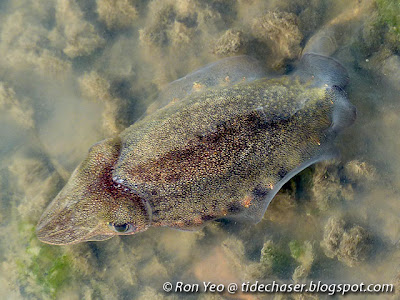
The Spineless Cuttlefish (Sepiella inermis) got its common name from the fact that its cuttlebone lacks a spine at the tip (unlike the one featured in the previous picture). It can be tentatively identified in field by the bright spots along the base of the caudal fins.
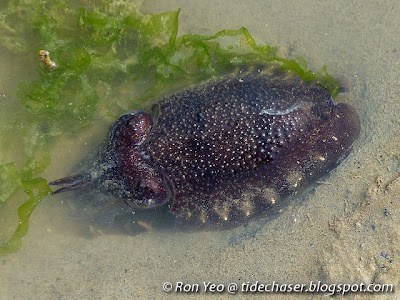
It can change its colour rather rapidly. In the picture above, the same animal turned dark coloured and the texture of the skin also changed from smooth to bumpy.

The above picture features the same Spineless Cuttlefish which took on a banded pattern instead after a while.
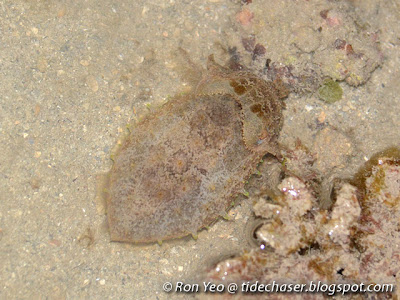
Indeed, most cuttlefish have the amazing ability of changing their colour, texture and shape, mostly for camouflaging purposes. The unknown cuttlefish (Sepia sp.) above blended in nicely with the surrounding seaweed with the brownish colour and protruding papillae when it was near the seaweed...

...but when it swam away, the colour and the texture changed.

This is yet another unknown cuttlefish (Sepia sp.), which appears to prefer clawing over the substrate using its arms rather than swimming. It is rather small, about 5cm long.

Another unknown cuttlefish (Sepia sp.) waiting to be identified.

Cuttlefish eggs seen on our shores are mostly black in colour, so I was a little surprised to read that most cuttlefish species actually lay white eggs.
D) Order Teuthida
Teuthid cephalopods, or squids, are typically elongate torpedo-shaped with a pair of round to triangular fins, though there are exceptions. They have eight arms and a pair of feeding tentacles, though the tentacles may be lost in the adults of some species. The arms may bear suckers or hooks, allowing them to have a good grip on their prey. Many species are very fast swimmers, and live in the open ocean or great depth. Their shell has been reduced greatly to just a thin, long and transparent internal structure, usually called a quill.

I have only photographed pencil squids (Family Loliginidae) in Singapore, since most squids are such fast swimmers that I have seen a lot more than I have photographed. Pencil squids are muscular and fast. The fins join at the rear end and may extend some or all the way along the sides of the mantle. Some species may harbour glowing bacteria, much like the bobtail squids.

The Bigfin Reef Squid (Sepioteuthis lessoniana) is possibly the commonest squid seen on our shores. It can grow up to more than 35cm long, and has fins which extend all the way along the body length. The widest part of the fin is closer to the rear end, unlike a cuttlefish which usually has fins of somewhat uniform width. It is most active at night, and sometimes many individuals of roughly the same size may gather and form schools. They are usually found in seagrass meadows or coral reefs.

The Bigfin Reef Squid can change its colour very quickly to blend into the surrounding.

The squid eggs that I have seen on our shores are white and somewhat cylindrical.
E) Order Octopoda
Cephalopods from this order, commonly called "octopuses", have eight arms with one or two rows of suckers, but no feeding tentacles. They usually have shot and squat bodies that are fused with the head, unlike most other cephalopods which the head and body (mantle) occur as two separate parts. Most species are bottom-living, but several species are partially or completely free-swimming and live in the open sea. Octopuses generally lack a shell, either internal or external, except a few which may have very reduced internal shells. The beak is hence the hardest part of the animal, which allows the octopus to squeeze into small cracks and crevices with its very flexible body.
There are two suborders: the cirrate octopuses (Suborder Cirrina) which have a pair of fins (one on each side of the body), and the suckers on their arms are bordered by two rows of finger-like outgrowths (cirri) ; and the incirrate octopuses (Suborder Incirrina) which lack both the fins and the cirri. In Singapore, only incirrate octopuses from the family Octopodidae have been recorded. Studies suggest that octopuses are possibly the most intelligent group of invertebrates, and are able to solve simple problems and possess both short-term and long-term memory.
I have not been able to identify the octopuses that I have seen in local waters, and so this is just a quick listing of photos in the hope that someone can help to identify them in the long run.

This octopus was seen on a reef flat among coral rubble.

This octopus was seen moving the corals in an intertidal coral reef.

This one was seen among coral rubble next to a seagrass meadow.

This octopus flattened itself and blended very nicely into the coral rubble near a rocky shore.

This octopus went thin and tall when I approached. It was seen among the coral rubble and seaweed.

This one was seen on a sandy-muddy substrate among seaweed.
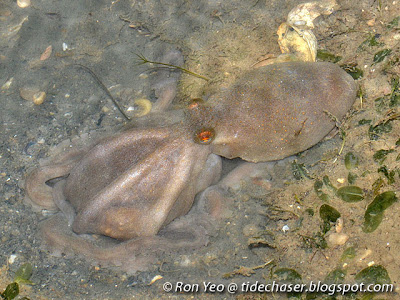
This octopus was also seen on a sandy-muddy substrate next to a patch of seagrass.
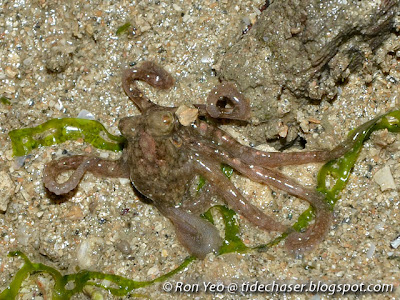
This one was seen crawling around the sand during low tide on a sandy area with seaweed. After I placed it back into water, it crawled out again.

This octopus was seen on a sandy-muddy area of a hidden reef, stranded during low tide.

This one was seen on a sandy patch next to a rocky shore and a small stretch of corals. When I placed it in a tidal pool, the colour and texture changed dramatically.
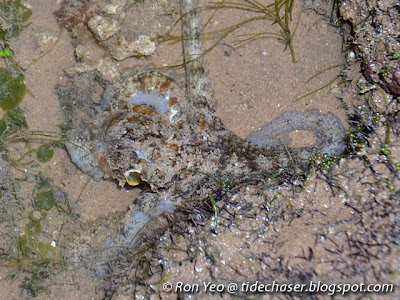
This is the same octopus as the previous photo, after I placed it in a tidal pool.
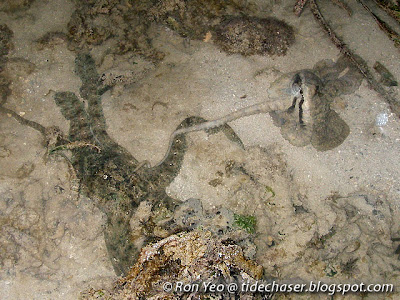
These two octopuses were mating among some coral rubble on a reef flat. The male changed its colour rather dramatically, switching from black-and-white to brownish, and then back to striped.

This octopus with eggs was seen among seaweed next to a disused earthenware on a sandy-muddy substrate.
References

Most cephalopods have a similar body plan. They have a mantle, which is basically a tube-like body to store the internal organs. They also have a funnel at the front extending out of the mantle. This funnel acts like a jet engine - the mantle stretches to suck water into the mantle cavity, then contracts and pushes the water out of the funnel, hence propelling the animal backwards. Most species have a pair of fins by the side of the mantle to aid in swimming.
They have a ring-like brain and are considered the smartest group of invertebrates. They also have two very developed eyes, though most are colour-blind. They have a hardened beak, much like the beak of a bird, which allows them to bite their prey or predators. Most have a radula, which is like a tongue with teeth on it, allowing them to tear up their prey.
Cephalopods have three hearts - two for pumping blood to the gills (known as branchial hearts), and one central heart for pumping the oxygenated blood to the rest of the body. Their blood is blue in colour, being copper-based, unlike the iron-based blood of mammals.
Except for the nautiluses which have a well-developed external shell, most cephalopods have much reduced shells or no shells at all.
They also have a very complex skin, which can change its colour or even texture, either for camouflaging or communication purposes. Most species can produce and squirt dark coloured inks to confuse predators - they can either squirt a huge cloud of ink to obscure the view of the predator, or a small cloud with more mucus, acting like a false body (pseudomorph), to distract the predator.
Cephalopods reproduce sexually. They have separate sexes that are fixed from birth. Usually, the males produce sperm packages (spermatophores), and have specially modified arms to hold and pass these packages to the females, which will either use them immediately for fertilisation, or store them to be used later.
Economically, they are an important source of food. Ecologically, they are important predators and prey in the marine ecosystems. Some scientists even suggest that the total biomass of cephalopods may match the total biomass of all fishes in the ocean.
There are seven extant orders of cephalopods, and out of which I have personally only seen members from five of them in Singapore. Unfortunately, the cephalopods of Singapore are severely understudied, and there is very little documentation on the field characteristics of identified living specimens. Hence, most of the photos I have below are unidentified, and hopefully, someone reading my blog can help to identify them.
A) Order Nautilida
There is only one extant family, Nautilidae, in this order. They are usually called "nautiluses", and fossil records suggest that they have hardly changed over the past 500 million years! Nautiluses are the only cephalopods with a true external shell, which they can withdraw completely into. Inside, the shell has many chambers (or camerae). A nautilus swims by drawing water into and out of the living chamber, and adjust its buoyancy by either removing water its chambers or allowing water from the blood to fill up the chambers slowly. It lacks sucker pads on its arms and tentacles, but instead has ridges on them which help the animal to grip on its prey. Nautiluses also lack the complex brains found in other cephalopods, but studies have shown that they have memory capabilities, and can adjust their responses to the same event over time.

Nautiluses are generally found in deep waters, except in areas where the sea temperature is lower. Hence, no live specimens have been recorded in Singapore so far. In fact, only incomplete shells and broken pieces were recorded until the year 2010, when a complete shell of a Chambered Nautilus (Nautilus pompilius) was found on Pulau Semakau. While empty nautilus shells are known to remain buoyant in the sea over long periods, the discovery of an intact shell raise interesting questions of whether a population can be found near Singapore waters, if not in Singapore waters.

The above features a living nautilus in a local aquarium.
B) Order Sepiolida
This order comprises the bobtail squids (Family Sepiolidae) and pygmy squids (Family Idiosepiidae). Previously, the bottletail squids (Family Sepiadariidae) were also placed under this order, but recent phylogenetic studies indicated that they should be placed with the cuttlefish instead. Cephalopods from this family generally are small-sized, usually not more than 10cm. They have eight arms and a pair of retractable feeding tentacles. Many species harbour glowing bacteria in their mantle.

Pygmy squids (Idiosepius spp., Family Idiosepiidae) are very tiny cephalopods, and do not exceed 3cm in length. They are mostly cigar-shaped, and have a pair of small rounded or kidney-shaped fins at the rear end of the mantle. They usually live among seagrass, seaweed or mangroves.

Pygmy squids have special glue glands producing sticky mucus allowing them to stick to objects, allowing them to hide from predators or ambush prey among seagrass and seaweed. To disconnect, they produce an acid to melt the mucus. They mostly hunt small arthropods.

Some pygmy squids do not only have the ability to change their colour, but can adjust their shape as well. The above squid was initially cigar-shaped, but got all bloated up and bend down its arms when I approached it.

This one did the reverse, and became all thin and even the arms were straightened when I approached it.

Bobtail squids (Family Sepiolidae) are small cephalopods with a rounded back end and a pair of rounded fins. They either have a reduced internal shell or none at all. Many species harbour the glowing bacteria mentioned earlier in a special organ within the gill cavity. The bacteria glow in such a way that the silhouette of the bobtail squid is concealed in the light, hence preventing predator below from detecting it. In return for their service, the bacteria get a shelter and are fed by the bobtail squid.

Most bobtail squids live at the bottom, hiding in the soft sediment in the day and emerging to feed at night. Many species can only be identified by their arms and suckers found in mature males, and hence they are very difficult to identify in the field. Some bobtail squids can produce a glue to attach a layer of sand around their body when they burrow, so that when they got flushed out by predators, they can blend in better with the surrounding sand to avoid being detected. Studies have shown that when some bobtail squids are flushed out by predator in the day, they can produce an acid to disconnect the entire coat of sand, and leave it behind as a decoy.
C) Order Sepiida
This order comprises the bottletail squids (Family Sepiadariidae) and cuttlefish (Family Sepiidae). They have eight arms and a pair of feeding tentacles which they can retract into pockets on the underside of the head by the sides. The posterior fin lobes are free, i.e. not connected to each other.
I have not seen bottletail squids (Family Sepiadariidae) in local waters yet. They superficially resemble bobtail squids, and were previously placed in the same order. Recently phylogenetic studies placed them in the same order as the cuttlefish. Unlike bobtail squids, bottletail squids have no light organ and no internal shell. Their fins are distinctly longer than wide, and all are able to produce large quantity of slimy mucus, possibly for deterring predators.

Cuttlefish (Family Sepiidae) have a fin along the full length of their body.

They have an internal, chambered gas-filled shell (cuttlebone) using for buoyancy control, much like the external shell of nautiluses.

The Spineless Cuttlefish (Sepiella inermis) got its common name from the fact that its cuttlebone lacks a spine at the tip (unlike the one featured in the previous picture). It can be tentatively identified in field by the bright spots along the base of the caudal fins.

It can change its colour rather rapidly. In the picture above, the same animal turned dark coloured and the texture of the skin also changed from smooth to bumpy.

The above picture features the same Spineless Cuttlefish which took on a banded pattern instead after a while.

Indeed, most cuttlefish have the amazing ability of changing their colour, texture and shape, mostly for camouflaging purposes. The unknown cuttlefish (Sepia sp.) above blended in nicely with the surrounding seaweed with the brownish colour and protruding papillae when it was near the seaweed...

...but when it swam away, the colour and the texture changed.

This is yet another unknown cuttlefish (Sepia sp.), which appears to prefer clawing over the substrate using its arms rather than swimming. It is rather small, about 5cm long.

Another unknown cuttlefish (Sepia sp.) waiting to be identified.

Cuttlefish eggs seen on our shores are mostly black in colour, so I was a little surprised to read that most cuttlefish species actually lay white eggs.
D) Order Teuthida
Teuthid cephalopods, or squids, are typically elongate torpedo-shaped with a pair of round to triangular fins, though there are exceptions. They have eight arms and a pair of feeding tentacles, though the tentacles may be lost in the adults of some species. The arms may bear suckers or hooks, allowing them to have a good grip on their prey. Many species are very fast swimmers, and live in the open ocean or great depth. Their shell has been reduced greatly to just a thin, long and transparent internal structure, usually called a quill.

I have only photographed pencil squids (Family Loliginidae) in Singapore, since most squids are such fast swimmers that I have seen a lot more than I have photographed. Pencil squids are muscular and fast. The fins join at the rear end and may extend some or all the way along the sides of the mantle. Some species may harbour glowing bacteria, much like the bobtail squids.

The Bigfin Reef Squid (Sepioteuthis lessoniana) is possibly the commonest squid seen on our shores. It can grow up to more than 35cm long, and has fins which extend all the way along the body length. The widest part of the fin is closer to the rear end, unlike a cuttlefish which usually has fins of somewhat uniform width. It is most active at night, and sometimes many individuals of roughly the same size may gather and form schools. They are usually found in seagrass meadows or coral reefs.

The Bigfin Reef Squid can change its colour very quickly to blend into the surrounding.

The squid eggs that I have seen on our shores are white and somewhat cylindrical.
E) Order Octopoda
Cephalopods from this order, commonly called "octopuses", have eight arms with one or two rows of suckers, but no feeding tentacles. They usually have shot and squat bodies that are fused with the head, unlike most other cephalopods which the head and body (mantle) occur as two separate parts. Most species are bottom-living, but several species are partially or completely free-swimming and live in the open sea. Octopuses generally lack a shell, either internal or external, except a few which may have very reduced internal shells. The beak is hence the hardest part of the animal, which allows the octopus to squeeze into small cracks and crevices with its very flexible body.
There are two suborders: the cirrate octopuses (Suborder Cirrina) which have a pair of fins (one on each side of the body), and the suckers on their arms are bordered by two rows of finger-like outgrowths (cirri) ; and the incirrate octopuses (Suborder Incirrina) which lack both the fins and the cirri. In Singapore, only incirrate octopuses from the family Octopodidae have been recorded. Studies suggest that octopuses are possibly the most intelligent group of invertebrates, and are able to solve simple problems and possess both short-term and long-term memory.
I have not been able to identify the octopuses that I have seen in local waters, and so this is just a quick listing of photos in the hope that someone can help to identify them in the long run.

This octopus was seen on a reef flat among coral rubble.

This octopus was seen moving the corals in an intertidal coral reef.

This one was seen among coral rubble next to a seagrass meadow.

This octopus flattened itself and blended very nicely into the coral rubble near a rocky shore.

This octopus went thin and tall when I approached. It was seen among the coral rubble and seaweed.

This one was seen on a sandy-muddy substrate among seaweed.

This octopus was also seen on a sandy-muddy substrate next to a patch of seagrass.

This one was seen crawling around the sand during low tide on a sandy area with seaweed. After I placed it back into water, it crawled out again.

This octopus was seen on a sandy-muddy area of a hidden reef, stranded during low tide.

This one was seen on a sandy patch next to a rocky shore and a small stretch of corals. When I placed it in a tidal pool, the colour and texture changed dramatically.

This is the same octopus as the previous photo, after I placed it in a tidal pool.

These two octopuses were mating among some coral rubble on a reef flat. The male changed its colour rather dramatically, switching from black-and-white to brownish, and then back to striped.

This octopus with eggs was seen among seaweed next to a disused earthenware on a sandy-muddy substrate.
References
- Carpenter, K. E. & V. H. Niem (eds), 1998-2001. FAO species identification guide for fishery purposes. The living marine resources of the Western Central Pacific. Volumes 1 to 6. FAO, Rome. pp. 1-4218.
- Jereb, P. & C. F. E. Roper (eds). 2005. Cephalopods of the world. An annotated and illustrated catalogue of cephalopod species known to date. Volume 1. Chambered nautiluses and sepioids (Nautilidae, Sepiidae, Sepiolidae, Sepiadariidae, Idiosepiidae and Spirulidae). FAO Species Catalogue for Fishery Purposes. No. 4, Vol. 1. FAO, Rome. 262 pp.
- Jereb, P. & C. F. E. Roper (eds). 2010. Cephalopods of the world. An annotated and illustrated catalogue of cephalopod species known to date. Volume 2. Myopsid and Oegopsid Squids. FAO Species Catalogue for Fishery Purposes. No. 4, Vol. 2. FAO, Rome. 605pp.
- Norman, M. D. 2000. Cephalopods: A world guide. Conch Books, Hackenheim, Germany. 320 pp.
- Tan, S. K. & H. P. M. Woo, 2010. A preliminary checklist of the molluscs of Singapore. Raffles Museum of Biodiversity Research, National University of Singapore, Singapore. 78 pp. Uploaded 02 June 2010.
- Tan, S. K. & R. K. H. Yeo, 2010. The intertidal molluscs of Pulau Semakau: preliminary results of “Project Semakau". Nature in Singapore, 3: 287–296.
- World Register of Marine Species. 2012. Retrieved Nov 14, 2012, from http://www.marinespecies.org.

No comments:
Post a Comment